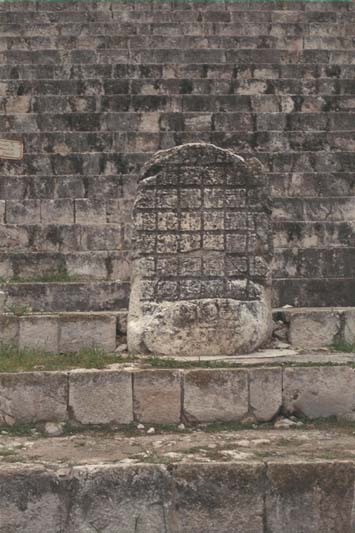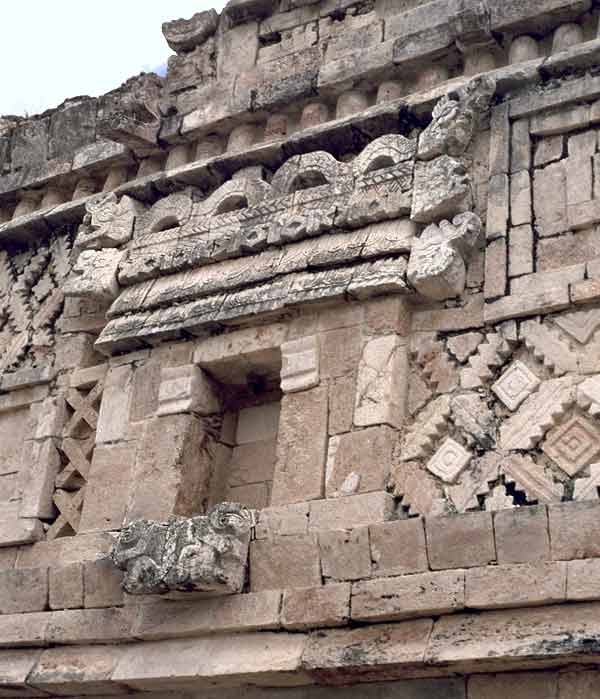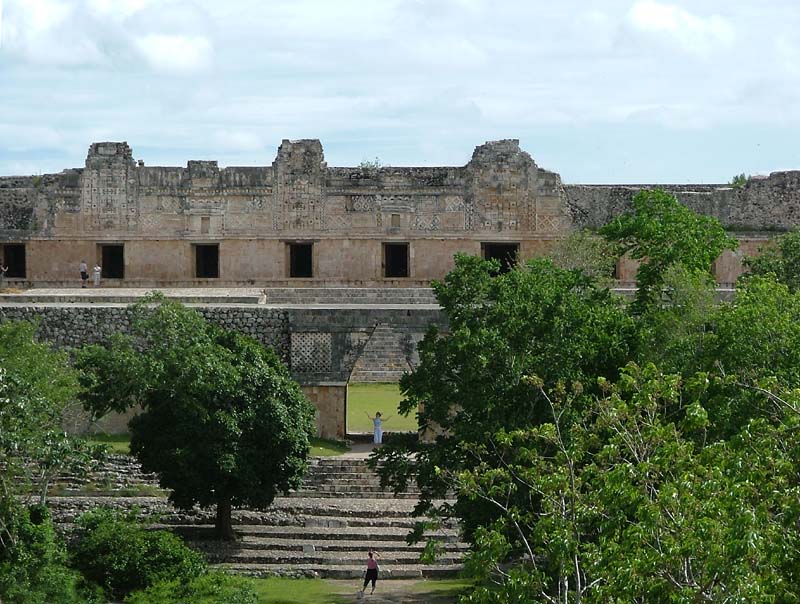

The North Structure of the Nunnery is some 270 feet long and has a complex arrangement of geometric elements, mask panels, and figural motifs adorning its facade.
"The North Building rests on the highest platform in the Quadrangle, arranged so that it stands on the level of the medial moldings of both the East and West Buildings. A grand stairway, flanked by two colonnaded buildings, rises from the court up to the North Building. The dark openings of eleven doorways punctuate the front facade, and an additional door penetrates each chambered room.
Nine towering stacks of masks divide the entablature of the front facade into compositional zones. Different individual symbols and images grace background patterns consisting of flower lattices and "cloud" scrolls."
Schele & Mathews, The Code of Kings, p. 269
Building Y, the small building flanking the stairway on the right, is important because of a painted capstone which records a longcount date of AD 907, which falls only 311 days after the date commemorated on the capstone in the East Structure. Both of the capstone dates...fit well with a radiocarpon date that has been reported for the North Structure of the Nunnery.
Jeff Kowalski, The Governor's Palace, p. 35

Linda Schele calls attention to the diagonal mat patterns on the frieze as diagnostic of the building's function, writing:
"The flower lattice consists of crossed diagonal members with recessed centers and zigzag edges. Flowers lie in the diamond shapes formed by the diagonals. We think this lattice replicates a kind of flower-laden scaffolding once used in Maya ritual. But more important, sixteenth-centry Yukatek dictionaries gloss nikte'il nah (literally "flower house") as "an assembly house," and say that it is the same as a popol-nah, "a community house, where they assemble to deal with the affairs of state, and to teach dancing for community festivals."
The presence of the flower lattice on this building marks it as a flower house, and thus tells us that it was used for council meetings, and for dancing in public festivals. The elevated level and the presence of a stela on the stairs suggest that the king and his nobles would have stood in front of the North Building to oversee rituals in the court below."
Schele & Mathews, The Code of Kings, p. 269-70

Stela 17, which possibly could have been a glyphic throne, sits at the base of the stairway of the North Building overlooking the expansive Quadrangle courtyard.
Even though it is horribly eroded, Jeff Kowalski thinks it probably contains a longcount date corresponding to A.D. 895 to 900, which could help date the construction of the Nunnery Quadrangle.

The so-called "Temple of Venus" gets its name from the row of Venus symbols on the frieze. It is believed to have been added after the other building in the Quadrangle had been completed.

The four circles at the top of this tower is a hard-to-recognize Tlaloc figure. The top two circles are his google-eyes, the lower are ear spools, and his mouth is framed with what looks like a mustache. He has a Venus sign of interlocking triangles under his chin
"Also set along the façade are towers of superimposed variants of rain-god masks, topped by goggle-eyed masks representing the central Mexican rain god Tlaloc. The presence of Tlaloc masks has sometimes been interpreted as evidence of "non-Classic" cultural influences. Representations of Tlaloc occur frequently in Late Classic Maya art, however, appearing in contexts associated with warfare, bloodletting, and sacrifice. This may account for their prominence on the North Structure, where captives are publicly displayed. Because Tlaloc was the god of ancient Teotihuacán, these masks also lent prestige and legitimacy to Uxmal's rulers."
Kowalski, Guide to Uxmal, p. 50-51
My friend Marion Canavan writes, "Personally, I think the "Tlaloc" at the top is an anthropomorphic Venus symbol. In Mesoamerica the planet Venus always took the form of a male god. I was told by local guides at Uxmal that the two intertwined triangles, seen below the chin of the top mask, is a symbol for Venus. The same symbol appears on numerous stones on the site, some of which are labelled as Venus symbols in the Uxmal museum."

"Miniature Maya huts above several of the doorways are surmounted by two-headed serpents, resembling the ceremonial "sky" bars carried by Maya rulers on Classic Maya stelae. Small jaguar sculptures beneath the doorways of the huts formed thrones for ruler figures (now missing) seated in the doorways."
Kowalski, Guide to Uxmal, p. 50
The bi-cephalic jaguar throne beneath the door is a miniature replica of the jaguar throne in front of the Governor's Palace.

Schele & Mathews refer to this little figure as simply "the fat quetzal."

A perfect vista of the North Building rising above the South Building, as seen from the platform of the House of the Turtles.